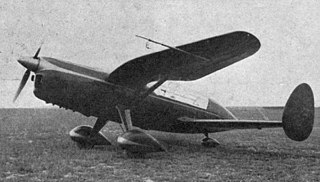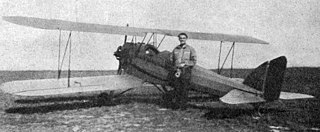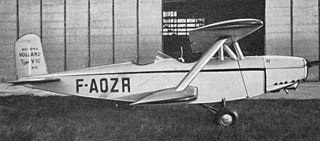Related Research Articles

The Potez 40 was a French three-engine, braced high-wing monoplane designed and built in response to a French government programme for colonial transport and policing aircraft duties.

The Caudron C.140 was a French tandem cockpit sesquiplane designed in 1928 as a combination of liaison aircraft and observer and gunnery trainer.

The Caudron C.67 was a simple single seat biplane with a low powered engine. It was built and flown in France in 1922.

The Albessard Triavion, sometimes known as the Peyret-Albessard Triavion, was a three surface aircraft, combining a tandem wing and conventional tailplane.
The S.E.C.A.T.-VI La Mouette or S.E.C.A.T. 60T La Mouette was a French two seat tourer built shortly before the outbreak of World War II.

The Delanne 20-T was a French tandem wing aircraft designed as an aerodynamic model for a larger fighter aircraft. It was tested during 1939.

The SFCA Maillet 20 was a French three seat tourer built in 1935. The Armée de l'Air ordered 30 for training and liaison and several were raced. The aircraft was developed through 1935 via cockpit layout and canopy changes to the provision of retracting landing gear.

The SFCA Lignel 20 was a French, single engine, low wing monoplane, one of a series of this type built by SFCA in the 1930s. It was capable of aerobatics but was primarily a racing aircraft.

The SFCA Lignel 10 was a French single seat aircraft designed to bridge a training gap between basic trainers and front-line fighters. The military requirement was soon dropped and only one was built.

The Delanne 11 was a French two seat touring aircraft. Only one was built.
The Gaucher RG.40 Week-End was a high-wing, two-seat, low-power, touring aircraft built in France in 1935. Three were built and later SECAT produced several rather similar designs, all from designer Rémy Gaucher.

Bessard-Millevoye Moineau (Sparrow) was a single seat, low-powered French biplane intended to increase participation in popular aviation. Only one was built.
The Caudron C.570 was a French twin-engine aircraft designed and built by Caudron in the mid-1930s. It was designed to function in multiple roles; as a bomber, passenger transport, paratroop aircraft, cargo aircraft and air ambulance.

The Volland V-10 was a French two seat, low-powered biplane notable for its extreme stagger. It first flew in 1936 and appeared at the Paris Aero Salon that year.
The Régnier 12 was a 1930s Belgian touring aircraft offering variants with different engines and seating plans. Only one was built.

The Wibault 260 R.2 was a contender for a French government contract for a long range, two seat reconnaissance aircraft, issued in 1928. There were eight prototypes in the 1931-2 contest and the Wibault was not selected for production.

The SABCA Demonty-Poncelet monoplane, Demonty-Poncelet limousine or SABCA-DP was a Belgian light aircraft first flown in 1924. It had two comfortable side-by side seats in a glazed cabin. Though it had competition successes in 1924 and 1925, it did not go into production.

The Peyret-Nessler Libellule (Dragonfly) was a French two-seat, low-powered parasol wing light aircraft built in 1927 to provide practical but economical flying. It was one of the first of these French avionettes.

The CAMS 54 was a strengthened and more powerful version of the French CAMS 51 civil transport and naval reconnaissance flying boat, developed for transatlantic flights. It is sometimes referred to as the 54 GR.

The Lumière-de Monge racer was built specifically to compete in the 1921 Coupe Deutsch de la Meurthe, flown at Etampes on 1 October 1921. As well as being fast, it was unusual in being a high wing monoplane which could be rapidly converted into a biplane by adding smaller lower wing. It crashed, fatally, before the race.
References
- 1 2 3 4 5 6 7 8 Frachet, André (4 March 1935). "Le bimoteur léger Duverne-Saran". Les Ailes (745): 3.
- ↑ Hirschauer, L.; Dolfus, Ch. (1933). L'Année Aeronautique 1933-34. Paris: Dunod. p. 60-61.
- ↑ Bruno Parmentier (17 January 2013). "Duverne-Saran" . Retrieved 28 March 2016.
- ↑ "Essais, raíds et records d'aviation". Le Journal: 3. 18 October 1935.
- ↑ "Les essais en vol". l'Aéro: 5. 8 May 1936.
- ↑ "Les Avions de Tourisme". Les Ailes (821): 4. 11 March 1937.
- ↑ "Les avions d'essais". Les Ailes (830): 11. 13 May 1937.
- ↑ "Les avions prives". Les Ailes (853): 15. 21 October 1937.
- ↑ "Les avions prives". Les Ailes (863): 15. 30 December 1937.
- ↑ "Les avions legers". Les Ailes (913): 10. 30 December 1937.
- ↑ Jack Erickson. "Outstanding Compilation of Horizontally Opposed Aero Engine Information" . Retrieved 30 March 2016.